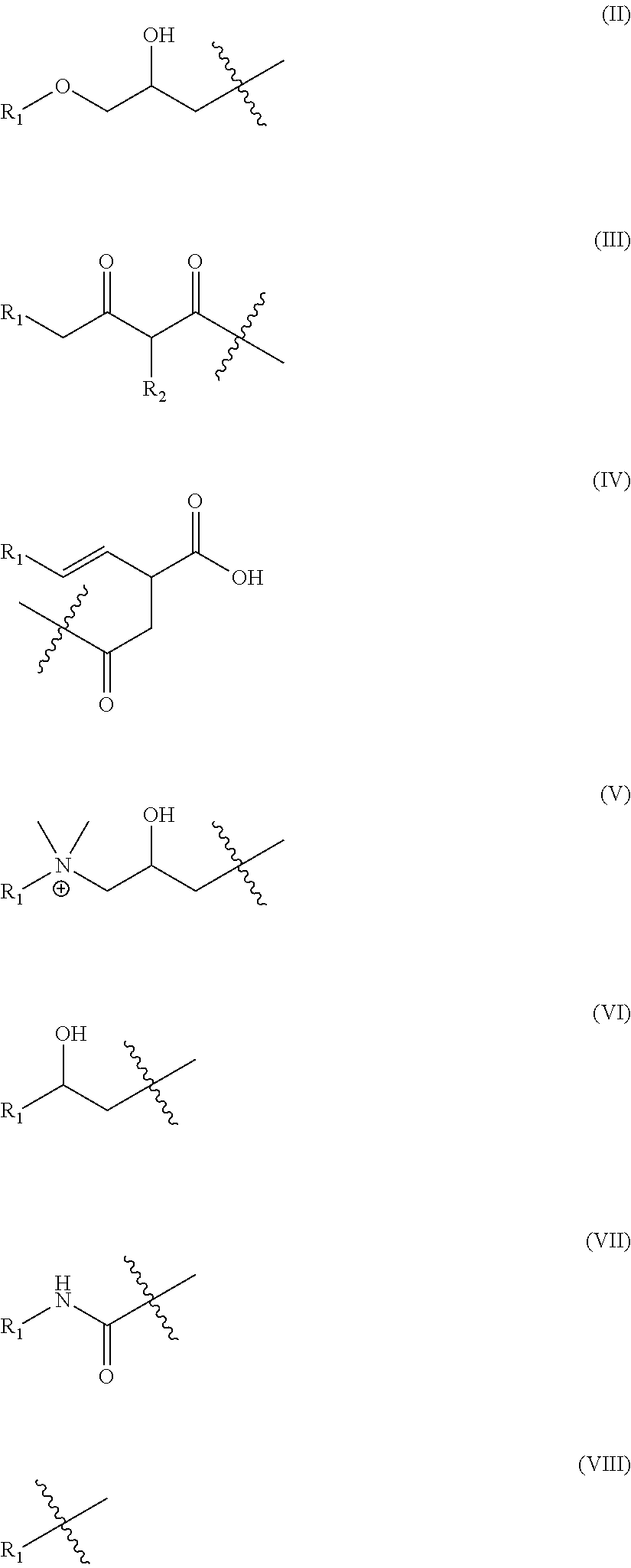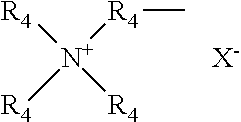Method of Treating Paper Forming Wire Surface
- Summary
- Abstract
- Description
- Claims
- Application Information
AI Technical Summary
Benefits of technology
Problems solved by technology
Method used
Image
Examples
example 1
[0046]The invention is illustrated in the following examples, which are provided for the purpose of representation, and are not to be construed as limiting the scope of the invention.
IdentificationDescriptionsCPresstige ® FP5500, polyamine cationic polymerH1DETA based polyaminoamide modified with 10% C9Hydrophobe*H2TETA based polyaminoamide modified with 10% C9Hydrophobe*S1Cocobis hydroxyethyl, methyl ammoniumS250 / 50 mixture of alkyl dimethyl benzyl ammonium chlorideand alkyl dimethyl ethyl benzyl ammonium chlorideS3Alkyl dimethyl benzyl ammonium chloride,S4Cetyl trimethylammonium bromideS5Tallow AmineS61-Hydroxyethyl, 2-heptadecenyl imidazolineS71-Hydroxyethyl, 2 coco imidazolineUBis(2-chloroethyl) ether-1,3-bis(3-(dimethylamino)propyl)urea copolymerNote:DETA: DiethylenetriamineTETA: Triethylenetetraamine
[0047]Among the examples listed above, the example C is a commercial product of Hercules Incorporated, Wilmington, Del., USA and widely used in papermaking industry to inhibit resi...
example 2
[0049]This example demonstrates the synergistic effect of the composition of the invention that combines a nonionic amphiphilic polymer and a cationic surfactant on inhibiting resinous and sticky substances from forming deposition on paper forming wire. Three samples used in the demonstration are described as follows:
IdentificationDescriptionsS61-Hydroxyethyl, 2-heptadecenyl imidazolineE1Polyethylene glycol modified with 25% C8 hydrophobeB50% S6 + 50% E
[0050]The peel test as described in Example 1 is employed to compare the performance of the above three materials. The test is conducted in a water containing 0 μeql / L AC and at the concentrations of 10 ppm and 20 ppm testing materials, on dry weight basis. The results of the peel test in are listed in Table 2. As can be seen, the sample B has a lower peel force than the sample E or S6 when they are used alone. The results in Table 2 clearly demonstrate that the combination of the samples E and S6 produces a synergistic effect on prot...
example 3
[0051]In this example, a sample, designated as E2, is created according to the present invention by combining a cationic agent of the invention and a NIAP according to the present invention. The cationic agent used in this example is the cationic polyurea U as described in the Example 1 and the MAP used is a copolymers of vinyl alcohol and vinyl alkonate (PVA / A) that has a degree of hydrolysis of around 87% and a molecular weight of about 150,000. The sample E1 has its active solid consisting of 75 wt % of U and 25 wt % of the PVA / A. The peel test as described in Example 1 is employed to compare the performance of E2 with U on inhibiting resinous and sticky substances from forming deposition on paper forming wire. The test is conducted in a water containing 0 μeql / L AC and at the concentrations of 2.5 ppm and 10 ppm testing materials, on dry weight basis. The results of the peel test in are listed in Table 3. As can be seen, the sample E2 demonstrates a lower peel force than the sam...
PUM
| Property | Measurement | Unit |
|---|---|---|
| Fraction | aaaaa | aaaaa |
| Fraction | aaaaa | aaaaa |
| Fraction | aaaaa | aaaaa |
Abstract
Description
Claims
Application Information
 Login to View More
Login to View More - R&D
- Intellectual Property
- Life Sciences
- Materials
- Tech Scout
- Unparalleled Data Quality
- Higher Quality Content
- 60% Fewer Hallucinations
Browse by: Latest US Patents, China's latest patents, Technical Efficacy Thesaurus, Application Domain, Technology Topic, Popular Technical Reports.
© 2025 PatSnap. All rights reserved.Legal|Privacy policy|Modern Slavery Act Transparency Statement|Sitemap|About US| Contact US: help@patsnap.com



